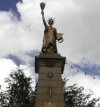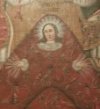Click on a thumbnail to enlarge the picture. When viewing the full-size
pictures, you can also view the remaining pictures "slideshow-style" by
clicking on the "Prev" or "Next" buttons.
 |
Potosi Corner —
Colorful buildings light up a small corner in the town of Potosí.
|
 |
Calle Quijarro —
The origins of this unbelievably windy street are unclear; the leading theory is that it was done intentionally to block the freezing mountain winds in winter-time and keep the street from becoming a wind tunnel. A few people, however, think it's so that the drunk miners can make it from one end to the other without hitting a wall.
|
 |
Historic Building —
Potosí features a great number of historic buildings, with ornate doorways and facades dating back hundreds of years. The twisted columns flanking this door are a novelty once ascribed to its owner, the Marquez de Otavi. Now, however, it's the home of the Banco Nacional.
|
 |
Cathedral —
The main cathedral dates back to the 1500s, with colonial-era tiles still found at the base of some columns inside.The more modern additions showed up during a reconstruction effort in the early 1800s, after most of it had collapsed.
|
 |
A Little Liberty —
Looking just a little out of place, the city's main square, Plaza 10 de Noviembre, has a scaled-down reproduction of the Statue of Liberty in it. The "bring us your poor, your huddled masses" plaque is absent, though, which strikes me as a wise idea: Bolivia probably doesn't need more.
|
 |
Casa Real de la Moneda —
The largest mint in the region has been converted into an extensive museum, showing how coinage was produced for most of the South American region here, along with exhibits on early transportation methods and lots of very bloody religious art. Visitors are greeted by the face of Bacchus. Nobody knows why some Frenchman hung this here in the 1860's, but the Roman God of wine has now been embraced as the patron saint of Potosí. (Whatever.)
|
 |
Casa Real de la Moneda - Courtyard —
Elaborately carved walkways and vines line the main courtyard inside the mint. Not everything is as scary as the entrance, thankfully.
|
 |
Virgin of the Mountain —
This anonymous painting is called the museum's "best iconographic work", probably because it sounds better than "eerie piece of crap". The point was to portray the crowning of the Virgin Mary, inside the mountain where all the town's silver was mined. Then Incan cultures get mixed in, as the Incan Gods of the Sun and Moon watch on. The painting mixes in about a dozen other allegories, but while I'll admit to getting most of the allegories, it didn't stop the painting from just looking ugly to me. Sorry.
|
 Photos By Date
Photos By Date